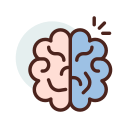Artikel Jurnal
Radiotherapy Protocol of Central Neurocytoma for Resource-limited Settings in the Absence of Official Guidelines: A Case Report and Review of the Literature
BACKGROUND: Central neurocytoma (CN) is one of the rarest brain tumors which can cause considerable threats to the patient. Studies and trials regarding its treatment are scarce, and no official guidelines are dedicated to this disease. The main principle of treatment generally consists of surgery and radiotherapy. The choice of radiotherapy is divided into conventional fractionated radiotherapy and stereotactic radiosurgery (SRS). However, access to SRS in developing countries such as Indonesia is still limited.AIM: We report a case delineating the timeline and process of treatment in CN with a review of the literature. METHODS:We report the case of a 29-year-old woman with a solid inhomogeneous mass (AP 5.63 × CC 5.36 × LL 5.16cm)in the right ventricle, attached to the septum pellucidum, as displayed on the magnetic resonance imaging (MRI). The patient had been vomiting for the past threeweeks and presented with bidirectional horizontal nystagmus. RESULTS:Cognitive evaluation with Montreal Cognitive Assessment (MoCA-Ina) demonstrated a mild cognitive impairment. Biopsy was performed, and pathology analysis revealed some cells with fibrillary background and some with a honeycomb-like appearance. The immunohistochemistry staining showed positive results with synaptophysin and neuronal nuclear protein. According to the WHO classification of the central nervous system tumors, the profile favored CN GradeII. Subtotal resection (STR) was performed to reduce the tumor mass, which was measured with MRI 2-month post-surgery (AP 4.09 × CC 3.01 × LL 4.13cm) and then followed by an external radiation program. Using intensity modulated radiation therapy (IMRT), a total dose of 54Gy was given in 27 fractions, with the average planning target volume of 54.3Gy. There was a minuscule reduction in tumor mass as seen in post-radiotherapy MRI (AP 4.00 × CC 3.86 × LL 3.63cm). After the last session and at the 18-month follow-up, the patient did not have any complaints or abnormalities during clinical assessment. Reevaluation using MoCA-Ina showed an improved cognitive function.CONCLUSIONS: In line with recent evidence, we demonstrated that STR followed by IMRT with the dosage of 54Gy in 27 fractions was a feasible treatment strategy for CN that resulted in cognitive improvement, with no side effects
Availability
Detail Information
- Series Title
-
-
- Call Number
-
362.1 DIO r
- Publisher
- Makedonia : Open Access Macedonian Journal of Medical Sciences., 2022
- Collation
-
-
- Language
-
English
- ISBN/ISSN
-
-
- Classification
-
362.1
- Content Type
-
-
- Media Type
-
-
- Carrier Type
-
-
- Edition
-
-
- Subject(s)
- Specific Detail Info
-
-
- Statement of Responsibility
-
Dion Firli Bramantyo
- Viewer
-
249
Other Information
- Tanggal Pelaksanaan - Dari
-
2024-12-31
- Tanggal Pelaksanaan - Sampai
-
2024-12-31
- Akreditasi
-
Tidak
Other version/related
No other version available
File Attachment
Comments
You must be logged in to post a comment

 Computer Science, Information & General Works
Computer Science, Information & General Works  Philosophy & Psychology
Philosophy & Psychology  Religion
Religion  Social Sciences
Social Sciences  Language
Language  Pure Science
Pure Science  Applied Sciences
Applied Sciences  Art & Recreation
Art & Recreation  Literature
Literature  History & Geography
History & Geography